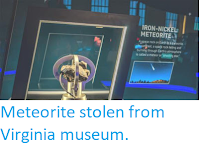A fragment of an asteroid that fell to Earth in June 2018 have been found on a game reserve in Botswana. Asteroid 2018 LA broke up in the atmosphere over the Botswana/South Africa border region on 2 June 2018, roughly eight hours after it had been discovered by the
University of Arizona's Mt. Lemmon Survey. This prompted a search for fragments of the object, led by scientists from the University of the Witwatersrand in South Africa, the Botswana International University of Science and Technology, and the Botswana Geoscience Institute, which eventually managed to locate a fragment of the meteorite in the Central Kalahari Game Reserve in Botswana this week, only the second time a fragment of an asteroid discovered before it impacted the Earth has ever been discovered (an asteroid is a body in space orbiting the Sum, a meteor a light in the sky caused by such an object burning as it enters the atmosphere, and a meteorite a fragment of rock from an asteroid that is found on the Earth). The fragment will be kept in the collection of the Botswana National Museum, where it will be available for study by scientists from around the globe.
A fragment of Asteroid 2018 LA, which was found in Botswana this week.
Objects
of this size probably enter the Earth's atmosphere several times a
year, though unless they do so over populated areas they are unlikely to
be noticed. They are officially described as fireballs if they produce a
light brighter than the planet Venus. The brightness of a meteor is caused by friction with
the Earth's atmosphere, which is typically far greater than that caused
by simple falling, due to the initial trajectory of the object. Such
objects typically eventually explode in an airburst called by the
friction, causing them to vanish as an luminous object. However this is
not the end of the story as such explosions result in the production of a
number of smaller objects, which fall to the ground under the influence
of gravity (which does not cause the luminescence associated with
friction-induced heating).
Scientists from Botswana and South Africa at the location where a fragment of Asteroid 2018 LA was discovered this week.
These 'dark objects' do not continue along the path
of the original bolide, but neither do they fall directly to the ground,
but rather follow a course determined by the atmospheric currents
(winds) through which the objects pass. Scientists are able to calculate potential trajectories for hypothetical dark
objects derived from meteors using data from weather monitoring services.
See also...
Follow Sciency Thoughts on Facebook.








